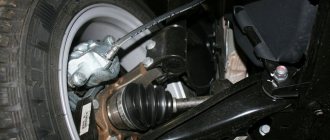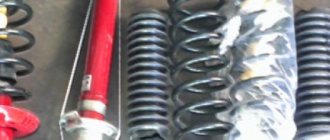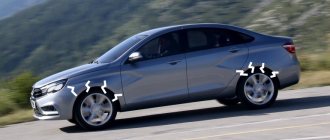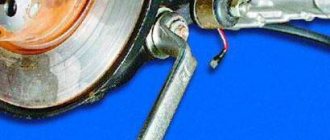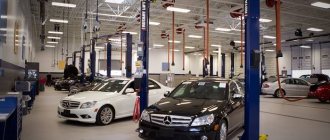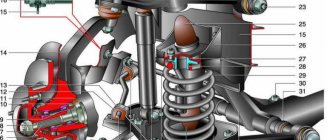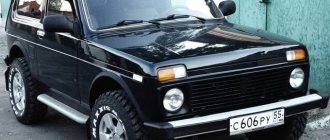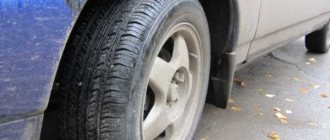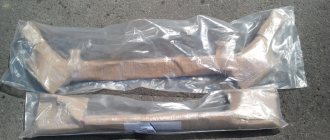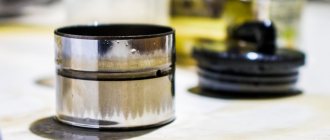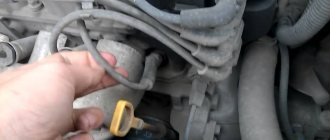Causes of extraneous noise and knocking
In order to carry out an independent inspection, and, if necessary, repairs, you will need a lift or inspection hole.
Support stand
For comparison: old and new support strut on Logan
Before you begin inspecting the suspension under the car, first assess the condition of the front strut supports. To do this, you need to open the hood and evaluate the gap on the spring stop cup.
Check the gaps!
If the gap exceeds 1 cm or it differs relative to the opposite side, this indicates that the supports have sagged and they do not absorb impacts on small bumps, therefore, they need to be replaced.
Shock absorber struts
The presence of a dull knock in parts of the front suspension may indicate defects in one of the shock absorber struts. The easiest way to diagnose is to alternately rock the car on the left and right sides. If there are working shock absorbers, the car will smoothly return to its original position, already on the first or second free play.
The presence of smudges and unsatisfactory condition of the bumpers will also indicate that the rack should be replaced.
Anti-roll bar link
This chassis element is checked when the vehicle is under load.
By rocking the car, you should pay attention to the movement of the cup relative to the lever itself. If this element malfunctions, it will jump and make a characteristic knock, which in turn, undoubtedly, is observed when driving on an uneven road
Inspection and replacement of the stabilizer bar link
The same goes for the anti-roll bar bushings. When they wear out, play and free movement will be felt in the places of contact with the rod itself. Diagnostics and replacement of stabilizer bushings can be carried out both on the ground and with the car suspended.
We recommend: How to do a car engine overhaul with your own hands
Silent blocks
The arrow marks the silent block
After the car has been raised, you should check the silent blocks in the suspension arms. In order to determine the degree of their wear, you will need a mount, with the help of which, by moving the lever on the subframe in the longitudinal and transverse directions, you can determine their play, as well as identify rubber defects.
On Renault Logan, the silent blocks are attached to the front suspension arm, so their replacement should be carried out on a removed element.
Spherical bearing
Diagnostics of a ball joint is diagnosed in the same way as silent blocks. By turning and pushing movements (left - right) you should influence the front suspension lever, and if the ball joint is faulty (there is play), moving it will not be difficult.
Ball boot diagnostics
The support on the Renault Logan is pressed into the front suspension arm. Therefore, before dismantling it, the lever must first be removed, and the replacement itself must be carried out using a press. Read more in the material: replacing and diagnosing a ball joint on a Renault Logan.
If the ball joint is sentenced to replacement, then it is important to know which ball joints are better!
The appearance of malfunctions in the engine mount
In order to detect problems in the condition of the motor support, it will be enough to conduct only a visual external inspection. At a high level of wear of this element, you will find the appearance of significant tears, as indicated in the photo below.
The broken support is shown on the left, and the new support is shown on the right. As a rule, problems with the engine mount can occur after 100 thousand km of the vehicle. In addition, noise in the supports may be accompanied by vibration of the engine itself. In this case, you may find black carbon deposits on the spark plugs. To determine the specific cause of knocking and shaking, conduct a detailed diagnosis of all vehicle systems.
Advice: remember - timely repairs (even if there is slight noise on small bumps, holes and uneven surfaces) will guarantee the durability of the car's front suspension in the future.
Possible rare causes of knocking
The stabilizer bar bracket is checked for integrity or noise. Its design contains bushings with rubber elements. They are connected by a rather fragile beam. Sometimes it bursts and makes a knocking sound when the car rocks. You can shake it by hand on the wheels turned to the side.
It happens that the supports on which the engine is mounted burst. While driving, the unfixed motor under the hood moves. With its protruding parts, it can knock on the car body. This knocking noise is often confused with the sounds of a problem suspension.
Knocks in the suspension and damping system components
-check whether the silent blocks in the car’s suspension arms are working properly.
You can check it yourself; for this you will need a flat mount. by moving the mount, both longitudinally and transversely, you can identify play and wear in the rubber bushing - this may be the cause of the knocking;
-the next step is to check the operation of the ball joints.
To check, you need to lift one side of the car using a jack.
Holding the wheel with both hands, shake it to the right, to the left while watching the behavior of the ball joint.
-we check the shock absorber struts, since due to a defect in one of the struts, a dull knock in the front suspension is possible.
To do this, you need to rock the front of the car one by one, on one side and the other.
A knock when swinging indicates a problem with the shock absorber struts;
-check the condition of the hub bearing.
It is necessary to lift the front part of the car using a jack, grab the lower and upper parts of the car wheel and try to rock it in a vertical plane; if there is wear on the bearing, you will feel it;
-check the condition of the car’s steering rods; how to do this is described in the next chapter.
To replace the bushings, you simply unscrew the brackets. The photo above shows the process of replacing the rear stabilizer bushings of a Volkswagen Polo Sedan. In some cases, squeaks can appear even with normal bushings. In this case, you need to dismantle the bushings and then clean them of dirt and sand, which cause unpleasant squeaks.
If you hear knocking or other noise in the front suspension when driving over small bumps, as well as when accelerating and braking, pay attention to the engine mounts. When they wear out, the amplitude of engine movement increases greatly
As a result, he hits the body.
On some cars, such as the Ford Focus or Renault Duster, the engine mounts are a whole mechanism with rubber bushings. Therefore, the knocking noise may be caused by wear of the bushings. Malfunctions of the supports can only be determined visually by carefully inspecting all engine mounting components.
Another common cause of knocking noise that is not related to the chassis is the brake system. Determining that it is the cause of extraneous noise is quite simple: when you press the brake pedal, the sound or rattling disappears. As soon as the pads are released, i.e.
The greatest number of knocks is found in the suspension and damping system. To find a fault, you will need to look under the car - you won’t be able to do it without an inspection hole or a lift.
Checking silent blocks
First of all, you should check the serviceability of the silent blocks in the car's suspension arms. To do this you will need a flat mount. With its help, you can determine the wear of silent blocks by moving the lever both in the longitudinal and transverse directions. The presence of backlashes, as well as defects in the rubber shell, lead to knocking noises.
Some levers are made in a collapsible version. Then you can replace the silent blocks yourself. To do this, you will have to completely dismantle the lever, and then use a special device with a mandrel to push the silent block out. It is better to lubricate the new part with oil to reduce friction during installation.
Diagnostics of ball joints
A number of control arm suspensions use ball joints that connect the control arm to the hub or shock absorber.
To diagnose the source of the knock, you need to hang one side of the car, and then grab the wheel with both hands and shake it left and right. At the same time, you need to observe the behavior of the ball.
To check your suspicions, you can use a pry bar or a powerful flat-head screwdriver. If there is play, the ball joint requires replacement.
If bolts and nuts are used as fasteners, the work can be done directly under the machine. When the manufacturer has secured the ball joint to the lever using rivets, the assembly will need to be first dismantled. Using a drill and electric drill, the rivets are removed and new ball rivets are secured with bolts and nuts.
Non-separable levers must be completely replaced. Attempts to convert them into collapsible structures can be costly for the car owner.
Diagnostics of shock absorber struts
The next problem area in the car's suspension is the shock absorber strut. A dull knock in the front suspension may indicate a defect in one of the strut elements. The simplest diagnosis of shock absorbers is performed by alternately swinging the left or right front part of the car.
A broken support bearing also often makes unpleasant sounds when moving. Its malfunction can be determined visually.
Racks, supports, springs
A strong knock in the front suspension occurs due to impacts on the car body. This happens when the shock absorption system wears out. In rare cases, the shock absorber spring can also be the culprit of the knocking, but this happens extremely rarely, since the springs are the strongest part of the assembly.
The sound occurs on small bumps when the shock absorbers take a sharp blow. The vibration damping system copes very poorly with such an active load, so rapid wear of the elements during frequent driving on uneven roads leads to such consequences. The result is wear of the rubber layer of the support.
To detect a malfunction, you will have to go through the entire rack, remove it along with the support, and for this you need to dismantle the wheel and partially disassemble the chassis. There will be a lot of work. To make sure it is the strut support that is the problem, you need to measure the distance from the support to the rubber stopper. Ideally, there should be no discrepancies, maximum 1–2 mm.
If the reading is higher, you will have to replace the rubber layer of the strut.
If you don’t want to do this yourself, then the service station will do this work much faster, albeit for a fee. Vibration and knocking should disappear immediately after replacement.
It is extremely rare that the cause of a knock is the rack itself, which has become severely worn out due to constant loads. The sound will be very loud, and the car will shake considerably on bumps.
Checking the strut is quite simple: press harder on the hood. If the rack is faulty, the car will sharply return to its original position with a characteristic loud knock, while the body will sway a little.
The source of the sound may be a loose nut inside the mechanism that can be tightened.
Well, the latest option is a complete malfunction of the shock absorber mechanism. This happens as a result of accidents and collisions. At first, no attention is paid to the knocking, but the problem is discovered much later.
Rare causes of knocking
The last thing they try to do is check the stabilizer bar bracket. Its design features rubber bushings that can wear out. And they are connected by a rather weak beam. It happens that it bursts and then when rocking, extraneous noise appears.
It happens that even the supports on which the engine itself is mounted can burst. Therefore, while driving, an unsecured engine can “walk” periodically touching the body, the sounds are very similar to problems with the suspension.
It’s not always worth rushing to the station to find out what problems you have with your car. It is often quite easy to independently diagnose the main components and check their condition. The smallest of them are quite capable of being replaced independently.
Let's sum it up
The appearance of extraneous knocks from the suspension area may indicate wear of springs, rods and silent blocks of levers, worn or requiring replacement shock absorbers and their bearings, shock absorber struts and problematic ball joints. As soon as such symptoms of malfunctions appear, the car owner should immediately contact a service center and carry out appropriate diagnostics and repairs to the vehicle. If you delay in contacting the workshop, then ultimately the suspension will require a major restoration.
17.02.2021
Other reasons
If diagnostics have been started and no obvious problems have been identified, you can pay attention to the following:
- A brake caliper is an element of the brake system, which, when the pedal is pressed under the influence of the created pressure in the brake hydraulic system (mechanical and electronic are quite rare), compresses the wearing pads. In some cases, misalignment is possible, due to which the pads will wear unevenly and a knock may appear during braking. You can check the caliper visually, as it should also have no defects.
- The hub or bearings are a common problem that leads to humming and knocking noises while driving. To check, the brake disc or drum must be removed. If installed bearings are severely damaged during dismantling, they spill out or have defects that can be identified visually. The bearing mounting method is pressing. That is why, when it gets wedged, the hub can wear out, as evidenced by the bearing turning. You can determine problems with the hub or bearings without dismantling work, for which you need to slightly rock the wheel to the side.
- Another sign is a loose wheel. Wheel rims need to be balanced.
Diagnostics of the vehicle elements listed above in this paragraph should be carried out periodically, since their failure will lead to brake failure or loss of controllability (there are known cases when the hub bursts due to severe overheating, as a result of which the wheel can jam at speed).
What other components cause knocking?
If you have checked all the components described above, but have not found out the cause of the knocking, pay attention to the stabilizer bushings. As a rule, their wear is accompanied not only by knocking on bumps, but also by squeaking. By the way, it is for this reason that the rear suspension most often creaks.
On some cars, such as the Ford Focus or Renault Duster, the engine mounts are a whole mechanism with rubber bushings. Therefore, the knocking noise may be caused by wear of the bushings. Malfunctions of the supports can only be determined visually by carefully inspecting all engine mounting components.
Source
Knocks in the suspension and damping system components
The greatest number of knocks is found in the suspension and damping system. To find a fault, you will need to look under the car - you won’t be able to do it without an inspection hole or a lift.
Knock in silent blocks
First of all, you should check the serviceability of the silent blocks in the car's suspension arms. To do this you will need a flat mount. With its help, you can determine the wear of silent blocks by moving the lever both in the longitudinal and transverse directions. The presence of backlashes, as well as defects in the rubber shell, lead to knocking noises.
Some levers are made in a collapsible version. Then you can replace the silent blocks yourself. To do this, you will have to completely dismantle the lever, and then use a special device with a mandrel to push the silent block out. It is better to lubricate the new part with oil to reduce friction during installation. The inner seating surface of the lever should be cleaned of rust and dirt. Installation of a new silent block is carried out using the same device as dismantling.
Knock in ball joints
A number of control arm suspensions use ball joints that connect the control arm to the hub or shock absorber. To diagnose the source of the knock, you need to hang one side of the car, and then grab the wheel with both hands and shake it left and right. At the same time, you need to observe the behavior of the ball.
To check your suspicions, you can use a pry bar or a powerful flat-head screwdriver. If there is play, the ball joint requires replacement.
You can clearly see how to identify a faulty ball joint in the video at the end of this article.
If bolts and nuts are used as fasteners, the work can be done directly under the machine. When the manufacturer has secured the ball joint to the lever using rivets, the assembly will need to be first dismantled. Using a drill and electric drill, the rivets are removed and new ball rivets are secured with bolts and nuts.
Non-separable levers must be completely replaced. Attempts to convert them into collapsible structures can be costly for the car owner.
Knocking shock absorber struts
The next problem area in the car's suspension is the shock absorber strut. A dull knock in the front suspension may indicate a defect in one of the strut elements.
The simplest diagnostics of shock absorbers is performed by alternately swinging the left or right front part of the car. In this case, the palm of the hand needs to be rested on the top of the rack, which usually goes out in the engine compartment. The driver will immediately feel the presence of knocking noises. We wrote in more detail about ways to check struts in the article on how to check shock absorbers.
A broken support bearing also often makes unpleasant sounds when moving. Its malfunction can be determined visually.
Front suspension installed with defects
A possible reason for the appearance of knocking on bumps may be the occurrence of defects in the lever system. At the same time, you will notice changes for the worse in the car's handling. The only culprit in this situation is a set of silent blocks.
To check for problems, you need to diagnose the levers. You can do it yourself using a regular mount. To do this, use the pry bar as an extended arm to create a counterweight and bend each of the arms in different directions. If you find significant play in the structure (discrepancy of more than 5-7 cm), then it is worth carrying out maintenance on the suspension.
If the machine has a collapsible structure, then you only need to replace the old set of silent blocks with a new one. The replacement process is as follows:
- First you need to dismantle the levers;
- Then the stage of pressing out the set of silent blocks from the fixed holes occurs. To do this, use a special mandrel;
- Install a new set of silent blocks, having previously generously lubricated each of them to reduce friction during operation. Also, do not forget to clean the mounting surface of the suspension from all dust and dirt before installation.
Front suspension
Tip: If the suspension was supplied with defects from the manufacturer, then in case of an unexpired warranty, you can contact the dealer, and he will be obliged to replace the defective parts free of charge. Also be sure to check the rear axle of the VAZ-2107.
Assessing the condition of shock absorber struts
The shock absorber itself very rarely makes extraneous sounds. And if this has already happened, therefore, the part is in extremely unsatisfactory condition, and in the future simply cannot be used on the vehicle.
The simplest and most common method of checking shock absorbers is to rock the car from the side where the suspected source of the problem is located. If, at the time of rocking, the car body smoothly takes its original position and there is no extraneous noise, therefore, the shock absorber strut is in good condition. If, after swinging, the shock absorber has difficulty lifting the car body, most likely the level of working fluid or gas in it has significantly decreased. This may be caused by a leak in the seal of its housing. In addition, when braking or coming into contact with road potholes, the faulty element cannot completely dampen body vibrations, as a result of which they are clearly felt in the cabin.
If during visual diagnostics it was not possible to determine whether the shock absorber is working or not, it must be removed from the vehicle for a detailed search for the problem.
Knock in the front suspension when driving on a flat road - looking for the problem
If the front suspension of your car is knocking, you have to go to a service center and look for the problem. But the issue is not always resolved during diagnosis. Firstly, the qualifications of the technicians may not be enough to detect the problem. Secondly, some elements of the chassis cannot be checked without disassembly. So you need to learn to look for problems based on the nature of the sound. A knock in the front suspension may occur when hitting bumps. We have already talked about such cases; they are not difficult to find. This type of problem can be found quite simply if you drive into a pit and ask an assistant to shake the car. At this time, it is enough to hold on to various suspension parts or release the silent blocks. This will help you find exactly the part that knocks when hitting obstacles.
If the knocking noise in the forward drive occurs on a flat road, the problem is more subtle. Finding it will not be easy, especially without experience and knowledge in this matter. It should be remembered that knocking can occur in different ways. It is by the nature of the sound that you can often understand what is knocking in your car. However, the concept of a smooth road in Russia is quite relative. So we will consider the issues of knocking of various parts, including sounds on small irregularities and smooth holes on the road. Knocks are also possible on a perfectly flat road. In this case, any rotation element may become unscrewed, which causes a knocking sound simply when turning the wheel. But it’s worth sorting everything out in order. There are a number of reasons that are worth checking if your car exhibits a clunking sound on relatively smooth roads in the suspension area.
Content
Often problems are solved by replacing CV joints. This is a rotary mechanism in the external version and an object of independent transmission of torque in the internal version. If before the mystical knocking sound appeared when turning, you did not hear crunching sounds, then the internal CV joint may be to blame. The outer one fails more often, but before failure it begins to crunch when turning. You can check the part as follows:
The process of replacing internal CV joints is quite complicated. Interestingly, the main reason for parts failure is a torn boot. A part that costs a hundred rubles damages an expensive mechanism that is very difficult to replace. So it is worth monitoring the condition of the anthers and always changing them if necessary.
There is a part in the car suspension that is difficult to check. If it knocks, it happens precisely on small and unnoticeable irregularities. The ball loses its lubricant and begins to move very difficultly inside the seat. This causes sounds like creaking, light knocking, and annoying rattling. An element fails for the following reasons:
The ball joint is very difficult to diagnose. To check it, it must be removed, which cannot be done without the help of a professional service. That is why they often do not sin on it when going through other suspension parts. It may well happen that you change half of the suspension until you get to the knock directly in the ball joint.
It is better to install only high-quality parts of the chassis. We are talking about original or European spare parts. Many motorists use Japanese KYB parts and buy quite adequate Monroe struts. The supports must be installed using original ones, despite their high cost. This is the only chance to get the necessary aspects of operation.
It often happens that after reassembling the entire chassis, it is time to check the steering rack. By moving the steering wheel left and right, you will hear small knocks if the rack has already begun to wear out. But this does not mean at all that it knocks during operation. It is difficult to give general recommendations here; there are different recommendations for owners of different cars:
The steering system likes to knock in domestic cars, as well as in cars older than 10 years. Changing the steering rack is very difficult due to the high cost of spare parts and the rather inconvenient location in many cars. Therefore, they prefer to perform this process on a service. Professionals will complete all tasks quite simply and quickly.
You can check while driving whether the rear silent blocks of the front control arms are knocking. You need to place your foot directly on the floor and listen to whether there is a knock on your foot. The same procedure should be done on the passenger seat. The stabilizer support bushings are checked by placing your foot or hand on the part of the body behind the pedals. However, if you have suspicions, you can simply change this element. We invite you to watch a short video with self-diagnosis of the Hyundai Solaris suspension:
Assessing the condition of shock absorber struts
The shock absorber itself very rarely makes extraneous sounds.
And if this has already happened, therefore, the part is in extremely unsatisfactory condition, and in the future simply cannot be used on the vehicle. The simplest and most common method of checking shock absorbers is to rock the car from the side where the suspected source of the problem is located. If, at the time of rocking, the car body smoothly takes its original position and there is no extraneous noise, therefore, the shock absorber strut is in good condition. If, after swinging, the shock absorber has difficulty lifting the car body, most likely the level of working fluid or gas in it has significantly decreased. This may be caused by a leak in the seal of its housing. In addition, when braking or coming into contact with road potholes, the faulty element cannot completely dampen body vibrations, as a result of which they are clearly felt in the cabin.
If during visual diagnostics it was not possible to determine whether the shock absorber is working or not, it must be removed from the vehicle for a detailed search for the problem.
Knock in rear suspension
Diagnosis of the rear suspension is faster because its design is simpler. There can be several reasons for the knocking sound - worn torque rod bushings (if any), loose wheel bolts, loose or broken exhaust pipe fastening, broken suspension spring coil, loosening of the short torque rod mounting bracket, recoil valve in the shock absorber, rear shock absorber bushings, released axle shaft, pad spacer bar. Also, unknown sounds may be caused by reasons not directly related to the suspension. For example, objects in the trunk, an unscrewed spare tire, and so on.
It is also recommended to check the exhaust pipe mounting and its general condition. After all, a burnt-out muffler produces extraneous sounds that a car enthusiast may mistake for a knock in the rear suspension. In addition, it is necessary to check all pipe fastening elements. If it is not securely fastened, then on uneven roads it can produce a small and dull knock, which the driver may mistake for problems with the suspension.
When diagnosing yourself, you need to check the following components (some of them may be absent on some car models):
Suspension check
- rear suspension guide structure;
- levers (transverse, longitudinal);
- anti-roll bar;
- rear shock absorbers;
- shock-absorbing springs;
- shock absorber cups and brackets;
- rubber bushings;
- rear axle beam;
- compression buffer;
- bearings.
Diagnostics of the guide structure
During the diagnostic process, you must perform the following steps:
- Check the force and condition of the beam, as well as the levers (if any). Make sure there is no deformation on these parts.
- Check the hinges. They may develop cracks due to wear and tear. This also leads to deformation.
It is worth checking the threaded connections of the flanges at their attachment points. Depending on the make and model of the car, they can be repaired or you will have to buy and install new ones. The above work must be performed in a car service center or in a garage with an inspection pit.
Diagnostics of suspension springs
Despite the fact that the steel from which the springs are made is strong, they can fail over time. Their individual coils break, so the spring stops working normally. To diagnose the spring, it is enough to carry out a visual inspection
In this case, it is worth paying attention to the absence of defects on the spring coils, as well as the integrity of the rubber inserts that are located in the places where they are installed. If a spring fails, it must be replaced; it cannot be repaired.
Rear shock absorbers
Used shock absorber boots
As with the front shock absorbers, it is necessary to diagnose the anthers. If necessary, replace them
When inspecting the shock absorber, you should also pay attention to the absence of oil leakage from its housing. If the shock absorber is collapsible, it makes sense to dismantle it and disassemble it to ensure that the internal elements are in good condition.
In this case, it is worth checking the rubber bushings inside, which often fail.
Additional reasons
If you have checked the parts listed above, but the rear knock still persists, you should pay attention to the following things:
- Stopping support. Here they proceed as in the case of the front suspension. When it is skewed, the caliper will make a loud sound, so diagnosing this malfunction is not difficult.
- Wheel bearing. You need to jack up the car completely or just the wheel you want to check. When rotating freely, the bearing should not make noise, knocking or creaking noises. When checking, the brake pad may rub against the disc, the sound of which is very similar to a squeak. Therefore, be careful when diagnosing.
What else can knock in the front suspension of a car?
Above we discussed the main reasons why the front suspension knocks. However, the list of potential malfunctions does not end there. For example, even when the shock absorbers, supports, stabilizer struts and other elements are in perfect order, the warrior still notices a knock in the right wheel or a knock in the left wheel; the knock can be localized in the bottom area, etc.
- In such a situation, it is necessary to check the steering. The fact is that the steering wheel is not so strongly affected by the vertical movement of the wheels, but there is a lateral force. As a result, knocking noises may occur when driving through a rut, especially during steering.
The knocks in this case are usually loud and hard. If the problem is not solved, in the future, even on small irregularities, the steering wheel will knock, the shocks are transmitted to the steering wheel. Usually, knocks and play in the steering wheel are caused by wear of the hinges of the steering tips and steering rods, since vibrations from the steering knuckle are transmitted to them.
We also recommend reading the article on how to replace power steering fluid. From this article you will learn when and why you need to change the oil in the power steering, as well as how to correctly change the oil in the power steering with your own hands.
To check the steering, you need to hang the wheel, then grab the wheel with your hands on the left and right in the middle, and then start pushing the wheel with sharp movements. If there is play transmitted to the rods and lugs, the malfunction is obvious. Please note that if no play is detected, then the wheel bearing may also be the cause of the knocking noise. To check this, you need to grab the top and bottom of the wheel, then swing it.
- We also add that sometimes it is not the suspension that can knock, but other elements. At the same time, the driver believes that the problem is with the car’s suspension, although in fact the culprit may be the engine mount or the brake system. For example, on bumps the engine may sway and knock on its mounts. Brake calipers or pads also often knock.
Of course, if standard diagnostic procedures do not produce results, you need to seek help from experienced specialists. It is also not recommended to immediately change expensive suspension elements when knocking noises appear. It often happens that it is enough to change the silent block or stabilizer bushing, after which the suspension works properly without unnecessary noise.
Detection of wear on silent blocks of levers
The silent block can be safely classified as consumables. Since this rubber-metal element is constantly subjected to high loads, temperature and mechanical stress, its service life does not last long.
First you need to inspect the moving hinges. Their rubber components should not have any damage or cracks. Otherwise, the silent block is considered broken and requires immediate replacement.
To accurately identify the damaged part, you need to rest a pry bar or a powerful screwdriver against the plane of the lever and shake it a little. The presence of play indicates the need to replace the element.
Ball joints
Let's consider diagnosing the knocking of the upper and lower ball joints on VAZ classic cars.
The knocking of ball joints when driving over bumps is characterized by a metallic dull sound, which simplifies the diagnosis of the problem.
To confirm your assumptions, you need to drive the car into an inspection hole, and in order not to remove the ball joints, since this is a labor-intensive job, use the diagnostic methods described below.
The first thing we need to do is unload the front suspension of the car.
Jack up the car and place reliable wooden or metal supports under the lower control arm.
Remove the wheel and lower the jack. All the load will go to the lower arms and supports, thereby unloading the suspension.
It turns out that it rests on the spring through the lever, and not on the wheel, through the ball joints, which are now in a free state.
Take a long prybar or crowbar and insert it between the trunnion and the upper support body as shown below and wiggle it up and down.
In this way we will check whether the ball pin of the upper support is loose in its body.
You can also check the upper support for play without removing the wheel. The machine must be jacked up as described above.
To do this, you need an assistant who must sit behind the wheel and press the brake pedal on command. At this time, you must jerk the wheel sharply along and against the movement, away from you and towards you.
In this way, we eliminate the hub bearing and if there is any play, it will only be the upper ball joint.
The lower support is checked in the same way. The pry bar must be inserted between the lower arm and the axle.
And also, using rocking movements, we check the play of the finger in the lower support.
Play in the lower support can be checked in another way. To do this, find the diagnostic plug and unscrew it.
Take a caliper and use a bore gauge to measure the depth of the hole to the ball joint. If you don’t have a caliper, you can use a straight wire or a thin stick with a ruler.
The hole depth should not be more than 11.8 mm. If the measurement number is higher, then the lower support requires replacement.
As for checking ball joints on VAZ 2108/09/10 and higher vehicles, there are some peculiarities here.
On these vehicles, it is not recommended to check the condition of the ball joints using pry bars and crowbars, as the results may be erroneous.
The best option that will allow you to accurately find out the condition of the part is:
- Drive the car into a pit or lift it with a lift;
- If the car is in a hole, then jack it up and support it;
- Remove the front wheel;
- Unscrew the two bolts that hold the ball in place with a 17mm wrench. You don’t need to touch the lower 19mm nut yet.
- Bend the lever down using a crowbar to access the part;
- If the ball joint moves freely in different directions, dangles and makes noise, then it’s time to change it; there’s a high probability that it’s the one making the knock;
- Replacing the ball begins with unscrewing the lower nut by 19.
Worn support bearing
These sounds appear in the same way as with an inelastic damper, but they are sharper and much louder. In order to make an accurate diagnosis in this case, it is necessary to remove the stand. It is recommended to take into account one rather interesting feature that is inherent in such breakdowns: bearing wear is always uneven. So, maximum wear is where it is constantly located when the car is driving straight. If after turning the steering wheel the knocking noise disappears for a while, then it is definitely a support bearing.
There is also another diagnostic method. It is quite old, but effective. You will need an assistant again. The second person should rock the machine up and down. At this time, the driver should feel the shock absorber rod with his hand. The knock will be transmitted to this rod.
If you compare these knocks in the front suspension when turning the wheels at different angles, you can draw some conclusions about the condition of the support bearing.
Another possible reason is that the nut on the upper support is loosely tightened, sometimes this happens.
Problems you can fix yourself
It is worth noting that the reasons for knocking in the front suspension can be different, and there are quite a lot of them. The most harmless of them is that the motor protection has lost some of its fasteners. Therefore, on an uneven surface it makes sounds that are similar to the knocking of worn parts. However, motorists should be aware that a foreign object could also get into the suspension connections. The listed faults are easy to identify during the diagnostic process and then eliminated.
When the car is moving, a knocking sound in the suspension may occur from shock absorbers that are out of order. This can be replaced if oil begins to leak from these undercarriage components. In this situation, it is advisable to contact a car service for repair or complete replacement, which is more preferable.
When a knock is heard in the front suspension, the cause of uncharacteristic sounds may be wear of the silent blocks and rubber-metal bushings. In this case, the car enthusiast should carefully examine the chassis levers. The driver can see the rubber on the silent blocks and bushings peeling off. In addition, if you pull the wheel towards you, if the parts wear out significantly, it will give way. In such situations, urgent replacement of these spare parts is required.
Rubber cushions, which are designed to be attached to the front axle gearbox and lower anti-roll bar arms, can fail. With good lighting and careful inspection, this can be easily noticed. The car owner will need to replace the airbags. It would not be superfluous to check the strength of the shock absorbers and the quality of the bushings for their fastenings. If malfunctions are found, you need to replace the bushings and tighten the bolts and nuts of the fastenings.
Struts and strut supports are a problem for every car
Even high-quality and reliable racks begin to struggle with unevenness and knock after prolonged use. For a Chinese spare part, a long service life of 1000 kilometers is considered, for an original Japanese or European one - 15-20 thousand. Struts and upper supports regularly fail on cars in Russia, and the reasons for this can be very different:
- the strut itself rarely fails completely; when the car is rocking, creaking and extraneous sounds will be heard, and the knock will be heard throughout the entire suspension at once;
- the support in most cases fails at the moment when the support bearing breaks, this happens in the event of a sudden collision with large uneven roads;
- Perhaps a simple tightening of the support or shock absorber fastening at the top point will help you; you need to check all fastening elements;
- If the struts break down, they may leak, which will be visible on the body, but this is not a prerequisite, but simply a recommendation for additional diagnostics of the suspension element.
It is better to install only high-quality parts of the chassis. We are talking about original or European spare parts. Many motorists use Japanese KYB parts and buy quite adequate Monroe struts. The supports must be installed using original ones, despite their high cost. This is the only chance to get the necessary aspects of operation.
Knock in rear suspension
Diagnosis of the rear suspension is faster because its design is simpler. There can be several reasons for the knocking sound - worn torque rod bushings (if any), loose wheel bolts, loose or broken exhaust pipe fastening, broken suspension spring coil, loosening of the short torque rod mounting bracket, recoil valve in the shock absorber, rear shock absorber bushings, released axle shaft, pad spacer bar. Also, unknown sounds may be caused by reasons not directly related to the suspension. For example, objects in the trunk, an unscrewed spare tire, and so on.
It is also recommended to check the exhaust pipe mounting and its general condition. After all, a burnt-out muffler produces extraneous sounds that a car enthusiast may mistake for a knock in the rear suspension. In addition, it is necessary to check all pipe fastening elements. If it is not securely fastened, then on uneven roads it can produce a small and dull knock, which the driver may mistake for problems with the suspension.
When diagnosing yourself, you need to check the following components (some of them may be absent on some car models):
Suspension check
- rear suspension guide structure;
- levers (transverse, longitudinal);
- anti-roll bar;
- rear shock absorbers;
- shock-absorbing springs;
- shock absorber cups and brackets;
- rubber bushings;
- rear axle beam;
- compression buffer;
- bearings.
Diagnostics of the guide structure
During the diagnostic process, you must perform the following steps:
- Check the force and condition of the beam, as well as the levers (if any). Make sure there is no deformation on these parts.
- Check the hinges. They may develop cracks due to wear and tear. This also leads to deformation.
It is worth checking the threaded connections of the flanges at their attachment points. Depending on the make and model of the car, they can be repaired or you will have to buy and install new ones. The above work must be performed in a car service center or in a garage with an inspection pit.
Diagnostics of suspension springs
Despite the fact that the steel from which the springs are made is strong, they can fail over time. Their individual coils break, so the spring stops working normally. To diagnose the spring, it is enough to carry out a visual inspection
In this case, it is worth paying attention to the absence of defects on the spring coils, as well as the integrity of the rubber inserts that are located in the places where they are installed. If a spring fails, it must be replaced; it cannot be repaired.
Rear shock absorbers
Used shock absorber boots
As with the front shock absorbers, it is necessary to diagnose the anthers. If necessary, replace them
When inspecting the shock absorber, you should also pay attention to the absence of oil leakage from its housing. If the shock absorber is collapsible, it makes sense to dismantle it and disassemble it to ensure that the internal elements are in good condition.
In this case, it is worth checking the rubber bushings inside, which often fail.
Additional reasons
If you have checked the parts listed above, but the rear knock still persists, you should pay attention to the following things:
- Stopping support. Here they proceed as in the case of the front suspension. When it is skewed, the caliper will make a loud sound, so diagnosing this malfunction is not difficult.
- Wheel bearing. You need to jack up the car completely or just the wheel you want to check. When rotating freely, the bearing should not make noise, knocking or creaking noises. When checking, the brake pad may rub against the disc, the sound of which is very similar to a squeak. Therefore, be careful when diagnosing.
Steering
Even for experienced service engineers from numerous car repair shops, finding the cause of extraneous knocking noises is a serious problem. Many people immediately recommend replacing the shock absorber strut. Here it is, new, on the car, and the strange knocking noise in the front suspension on small bumps has not gone away. The car owner goes to another service center, but there they offer him to replace the support bearing, but even after that the knocking noise does not disappear.
When diagnosing the front suspension, experienced car owners begin checking with the steering system.
Often the steering rack can knock, and the sound can easily be confused with the sound of a shock absorber strut knocking. If it is heard on a shallow gravel road, then this is definitely a faulty steering rack. In this case, sounds will be heard only from one side. In addition to knocking, you can feel vibrations in the steering wheel.
Support bearing
The sounds that appear are very similar to the character of the worn out damper. To detect the malfunction, you will need to remove the rack itself. If the knock only occurs when driving straight, then the culprit is obvious. Since wear of the largest part occurs precisely during straight-line movements, the sound usually disappears when turning. You can finally make sure with a partner, who should rock the car vertically, and at this time you hold the rack from below; if you feel a slight vibration, then the problem has been found.
